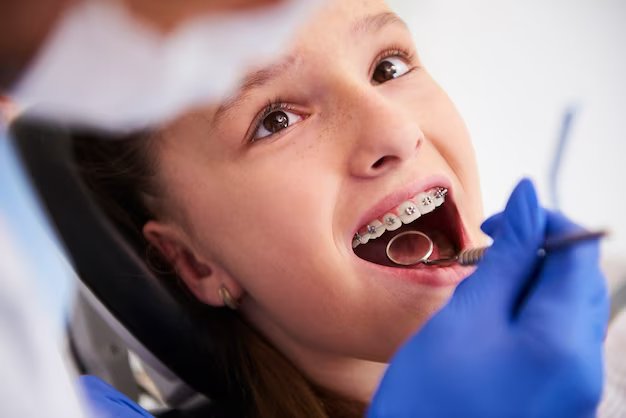What Are the Differences of Clear Braces VS Metal Braces
May 9, 2023
What Are the Differences of Clear Braces VS Metal Braces
You might be considering Glow Orthodontics if your teeth are crooked or out of alignment. There are many various kinds of braces available. However, there’s no denying that metal and clear retainers are the most widely used.
Undoubtedly, both types are perfect. However, most of our customers are still unsure which choice is most appropriate for them, and contradictory guidance from relatives and close associates and online forums isn’t helpful! Here we review the key distinctions between the two and some advantages and disadvantages. You may employ it to guide your choice.

What Are Ceramic Braces?
Clear braces, also known as transparent braces or clear ceramic braces, use solid alumina bands that are either transparent or tooth coloured. They are, therefore, more discrete and unnoticeable than traditional braces. To hide the presence of clear orthodontics, the wire that connects them may also be rendered tooth coloured.
Despite the braces’ subtler hue, they are prone to colour fading more readily. In your therapy, avoiding dark drinks like cappuccino and red wines is advised.
Overall, clear braces are a fantastic choice for treating all dental problems.
What are Metal Braces?
The earliest and most widely recognized forms of retainers are metal retainers, also called traditional braces. Furthermore, despite numerous improvements, orthodontics continues to be the preferred option. They’re the least costly choice for molars alignment that is both secure and efficient.
They are made up of metal aligners, cables, and elastics that work to address even the most serious orthodontic issues. Dental professionals now use arch cords that are heat activated to facilitate simpler changes

Clear Braces Vs Metal Braces
Clear and metal retainers use similar techniques to attain dental alignment and a radiant grin. The substance that the braces are constructed of makes the most significant impact.
Fittings for metal braces are constructed of surgical-grade stainless steel. Polycrystalline alumina is used in porcelain braces, which can be both clear and the same tone as the enamel on your teeth.
Ceramic braces are preferable due to their discreet look because stainless steel is obvious when contrasted with your teeth’s natural whiteness. Additionally, the parentheses may be translucent. Both shift their dentures in a specific way using bands of rubber.
Other Notable Differences between Metal and Clear Braces
Resilience
Because the brace’s substance is less potent than stainless steel, clear braces tend to be less long-lasting than metal ones.
According to research, transparent or porcelain clips are over two times more likely to crack or fall out than those made of metal. Due diligence and accountability are therefore crucial. Refrain from eating any crispy meals or solid sweets to prevent cracking them.
Arch Wires
The pliable metal archwire that links brackets together for clear braces can also be manufactured in a lighter shade. The available colour is silver, white, or a translucent shade miming the frames.
Your porcelain orthodontics may be virtually undetectable by other people due to the use of metal and tooth colour frames. Because it avoids the “metal mouth” appearance, this choice is preferred by professionals and students who desire aligned teeth.

Enamel Wear
Enamel deterioration might pose an issue if you wear clear aligners on your top and bottom arches. The protective layer of enamel on the anterior part of the upper teeth may erode due to orthodontic appliances on the lower angle.
Because of the sharp character of the traditional metal used in their construction, this can occur when eating or swallowing food. Due to improper dental treatment, the teeth may become more vulnerable to tooth disease.
Metal braces on the rear teeth might be more successful for some individuals, particularly those with extreme overbites. Otherwise, their dental health would be affected.
Staining
Clear braces are also more likely to get stained since they are lighter in the shade. Those who work with clear retainers should avoid dark meals and beverages. Dining and drinking include stews, sauces, red wine, tea, coffee, etc. The transparent or translucent braces can become stained or discoloured by any of these.
You can lessen the possibility of discoloration by using straws or brushing your teeth immediately after. You must be completely on track with your dental care for these.
Cost
The braces’ more fragile and costly construction accounts for the higher price.
Both metal braces & ceramic braces generally range in price from $4500 to $7000. This fee covers the dental appliance, in-office appointments, clasps, and post-treatment maintenance.

Which are Preferable, Metal or Clear braces?
This only relies on the patient in question as both retainers have the same framework and process, other than how they look. However, transparent versus metallic braces have particular benefits and drawbacks, such as price. Before selecting one in particular, you need to be aware of them.
Pros and Cons of Clear Braces
Pros
· Ceramic brackets also have a visual benefit. Teens favour them because they aren’t very noticeable.
· Unlike rigid metal brackets, clear aligners do not hurt the lips.
Cons
· Ceramic brackets require more maintenance because the clear retainers corrode and must be changed after a while, costing more than traditional metal braces.
· Sustainability is another significant distinction between the advantages and disadvantages of transparent and metal brackets. Compared to metal braces, ceramic braces are less sturdy.
Pros and Cons of Metal Braces
Pros
· Their affordable price ranks first among the benefits and drawbacks of metal braces.
· Since metal supports won’t rust easily, they require less maintenance.
· The powerful metallic hold of metal supports makes them more efficient and hastens the completion of tasks.
Cons
· Being visible is their biggest disadvantage, and their tight grasp can be uncomfortable initially.
· Some delicate individuals may develop oral sores as a result.
Both Metal and Clear Braces; Successful Orthodontic Treatment Options
As a whole, both metal and clear aligners are fantastic therapy choices for all individuals. The same dental problems, such as overbites, cross-bites, under-bites, wide bites, and inconsistencies, are addressed by both treatments. Ceramic braces may require more time to produce outcomes, but nowadays, there are very few, if any, variations in orthodontic treatment timespan.
Contrary to transparent retainers that only function as long as you wear braces, aligners are bonded to your teeth and are designed to correct your bite continuously, every moment of the day and every day of the week. The best choice for you will depend on your money and preferences for life.
Final Thoughts
Do you struggle to choose between metal and transparent braces? If yes, planning an appointment at our dental clinic will allow you to review each choice and help you decide which is most suitable for your requirements. To begin, get in touch with Glow Orthodontics right away. Our excellent experts are ready to provide a personalized strategy and treatment. We have specialists prepared to discuss orthodontics, Invisalign, or braces.